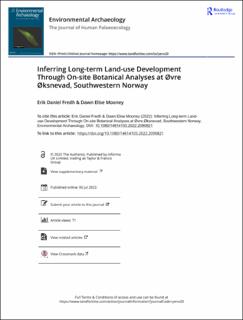Inferring Long-term Landuse Development Through On-site Botanical Analyses at Øvre Øksnevad, Southwestern Norway
Peer reviewed, Journal article
Published version
Permanent lenke
https://hdl.handle.net/11250/3010406Utgivelsesdato
2022-07Metadata
Vis full innførselSamlinger
- Articles (AmS) [145]
- Publikasjoner fra CRIStin [4317]
Originalversjon
Fredh, E.D., Mooney, D.E. (2022) Inferring Long-term Land-use Development Through On-site Botanical Analyses at Øvre Øksnevad, Southwestern Norway. Environmental Archaeology 10.1080/14614103.2022.2090821Sammendrag
This study analysed pollen and plant macrofossils from mainly Bronze Age and Iron Age funerary, agricultural and settlement remains, to infer local plant exploitation and long-term land-use development at Øvre Øksnevad in southwestern Norway. The results showed that deciduous woodland covered the site prior to c. 2100 BC. After this, until c. 500 BC, the vegetation became dominated by grasses/herbs, while several phases of land clearance and cultivation were identified. The main human activity on the site was c. 600-300 BC, when a settlement was established and most of the 103 cairns registered at the site were constructed. Grazing on heathland was the main land-use from 300 BC, until another short-lived settlement was established c. AD 1-200, while regular burning of the heathland occurred from c. AD 1300. The relatively short-lived settlement at Øvre Øksnevad suggests it was marginal and only used during times of high population pressure, a conclusion which is supported by the botanical evidence. This study demonstrates how comprehensive sampling for botanical remains can contribute to the understanding of complex archaeological sites, including local land-use development and human-plant interactions.

